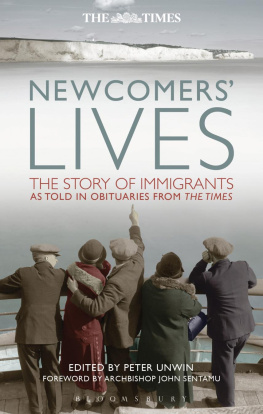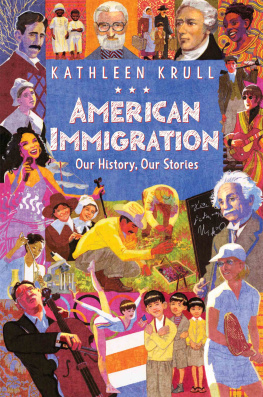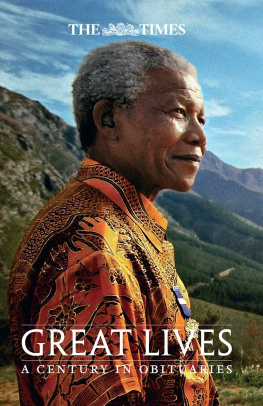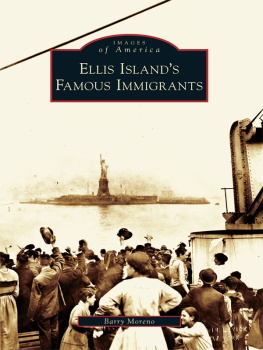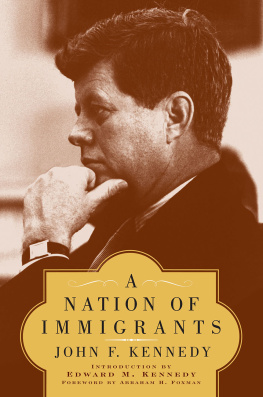As editor, I am indebted to the true authors of this book, the many anonymous men and women who between 1861 and 2011 contributed the individual obituaries which make it up. I am grateful also to the Archbishop of York for agreeing to provide the foreword; to Ian Brunskill, the Obituaries Editor of The Times , and his colleagues, especially Fiona Wilson and Melissa van der Klugt, for their work in tracking down individual obituaries in their archives; to Kim Storry, David Defew and Robert Bullard, who prepared the text for publication; and to Robin Baird-Smith and Nicola Rusk at Bloomsbury for bringing the whole project to completion.
Defender of London and Malta in the Second World War
February 7, 1975
Air Chief Marshal Sir Keith Park, GCB, KBE, MC, DFC, who died yesterday in hospital in Auckland, New Zealand, at the age of 82, had a distinguished career of nearly 36 years with the New Zealand and British armed forces, and was in command of forces which greatly contributed to the defeat of the Axis countries in two principal war theatres. In 1940 he became AOC No 11 Group, Fighter Command, which bore the brunt of the fighting in the Battle of Britain; later he successfully used his wide knowledge of air defence in Malta.
Keith Rodney Park was born at Thames, New Zealand, on June 15, 1892, the son of Professor J. Park, and was educated at Kings College, Auckland, and Selwyn Collegiate School, Dunedin, Otago Boys School and Otago University of Mines. In 1911-13 he served as a private in the New Zealand Field Artillery (Territorial Force) and in December, 1914, joined the NZ Expeditionary Force. He was commissioned in the Royal Field Artillery in 1915, and transferred to the RA (Regular Army) in 1916, seeing service in Gallipoli and France.
A year later he was seconded to the Royal Flying Corps and on the formation of the Royal Air Force in 1918 was promoted captain. Between 1917 and 1919 he served with Nos 8 and 38 (Reserve) Squadrons and No 48 Squadron, becoming commanding officer of the last-named on April 10, 1918. He gained the MC and bar in 1917, the Croix de Guerre in 1918, and the DFC in 1919.
In between the wars he commanded RAF Northolt, and was chief instructor of the Oxford University Air Squadron. He took the Imperial Defence College course in 1937, became officer commanding RAF Tangmere in January, 1938, and later that year, as air commodore, and became senior air staff officer at HQ, RAF Fighter Command.
In April, 1940, he was appointed Air Officer Commanding, No 11 Group, being confirmed in the rank of air vice-marshal the following July. No 11 Group was responsible for the greater part of protective fighter patrols, and after the German invasion of the Low Countries in May, 1940, Park on more than one occasion flew his own Hurricane over Dunkirk to gain first-hand intelligence of the progress of the evacuation. When the Battle of Britain began Park instructed his Hurricane and Spitfire pilots to split their attacks, half going for the bombers and the others attacking the escort, tactics which resulted in the German formations flying tighter and thus presenting better targets.
Towards the end of the Battle, after heavy attacks on No 11 Groups stations, Parks handling of his fighters, and Dowdings overall strategy, were the subject of an informal inquiry, instigated primarily by the AOC, No 12 Group (which covered the Midlands), Air Vice-Marshal T. Leigh-Mallory. Park with the greatest area to protect, stretching from Southampton to Norwich had intelligently used his squadrons, with the help of radar, to place them where the enemy raids were expected, and successfully broke up the formations, even though he had very little warning of their approach. Leigh-Mallory, on the other hand, employed his fighters in larger wing formations, concentrating as many as five or even seven squadrons against the raiding bombers, having had time to amass them and in any case having by that time a better idea of the enemys targets. The differences between the two commanders became so pronounced that eventually the Air Council had to intervene. As it happened, the wing tactics were officially more favoured, and Park, along with Dowding, was moved to another post. But the fact remains that the Battle of Britain was won while Park commanded the largest of the fighter groups.
While the battle was on he flew 100 hours, mainly in his own fighter. He had, at the end of July, 1940, in cooperation with the Vice-Admiral, Dover, acquired some Lysander aircraft to work in conjunction with launches to retrieve aircrew who had come down in the sea, which may be regarded as the beginning of a comprehensive air/sea rescue organization.
In December, 1940, Park became AOC, No 23 Group, Training Command, where his hard-won experience could be passed on to the next generation of pilots. He was appointed AOC, Egypt, in January, 1942 and in July, 1942, became AOC Malta, where his first-hand experience of air defence was immediately put to good use. He introduced new tactics, instructing his pilots (then beginning to receive Spitfires in place of Hurricanes) to intercept enemy raids well out to sea and, besides attaining greater victories, reduced the possibility of bombs falling on the island itself.
By the skilful use of his still-limited fighters and bombers he was able to restrict movements of enemy convoys to North Africa. His aircraft supported Tedders forces at El Alamein, the advance to Tunisia, and the invasion of Sicily. When supplies began to flow more readily into the Mediterranean, Park, with typical energy, began intensive modernization of the Malta bases. He became AOC-in-C, RAF Middle East, in January, 1944 and when the emphasis of the war switched from Europe to the Far East Allied Air Commander, South-East Asia, in February, 1945. Here he assumed the immense responsibility of providing a colossal airlift by RAF and American aircraft of materials to support the Allied troops in Burma, besides the overall control of bombers and fighters, which contributed to the successful conclusion of the war in the Far East.
Park retired from the Service in December, 1946. In 1947 Oxford University conferred an honorary DCL on him. He married Dorothy Marguerite, daughter of Lieutenant Colonel Woodbine Parish, CMG, CBE, in 1918. He had two sons one of whom was killed on active service in 1951. His wife died in 1971.
Sir Keith Park was born on June 15, 1892, and died on February 6, 1975.
The father of the Mini
October 4, 1988
With the death at the age of 81 of Sir Alec Issigonis, CBE, FRS, on October 2, Britain has lost its most famous car designer, a man whose name will forever be linked with the Mini, the revolutionary car he introduced in 1959 and which remains in production in fundamentally unchanged form to this day. Earlier, as chief engineer of Morris Motors, he had been responsible for another outstandingly successful car, the Morris Minor, over 1.3 million examples of which were produced between 1948 and 1971, and which has subsequently become a collectors item for classic car enthusiasts.
Alexander Arnold Constantine Issigonis was born on November 18, 1906, in Smyrna, Asia Minor, the son of a Bavarian-born mother and British-naturalized father of Greek extraction. In 1922 the family found themselves amongst the many evacuees fleeing the conflict between the Turks and Greeks.
They planned to rebuild their life in England, but Alecs father, by then in poor health, died in Malta, leaving Mrs Issigonis to complete the journey with her 16-year-old son. These were difficult times, but she managed to integrate her son, already fascinated by cars and engines, into an educational background suited to his developing technical abilities.
His skill on the drawing board pointed towards an art school course but he insisted that he should join the Battersea Polytechnic where, although he failed to matriculate, he quickly revealed his potential as a practical engineer. His studies over, he spent several months touring the Continent by car with his mother, then he returned to England to face the task of becoming the family breadwinner.
Next page
